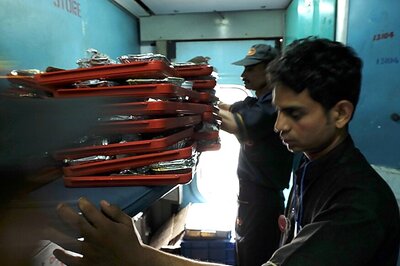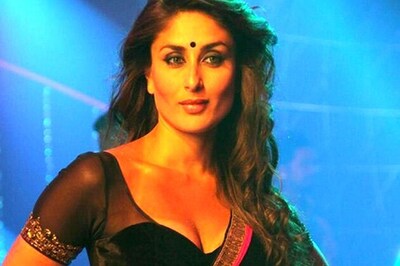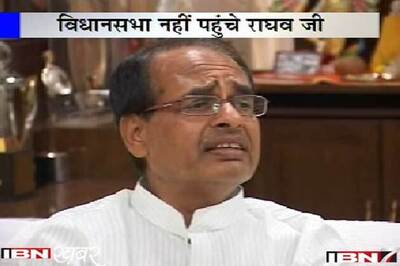
views
Mumbai: With every Mumbai marathon, now a fixture on the city's calendar and in its ninth year running (pun intended) come new twists and turns, some transformations and tweaks as each race year is a learning experience, both for organizers and runners. One remembers nine years ago, the marathon was held in February where Mumbai's merciless heat saw runners wilting away before they could reach the finish line. Then, through the years one saw route changes as organizers sought to de-congest the finish lines. Various other changes became fixtures in the event. Now, a new facet has been added to the event.
For the first time, a dedicated group of pace-setters is going to be part of the 42-km race, to help full marathoners, many of them novices with butterflies in their stomach, finish the race in particular time goals. The Standard Chartered has a website with a section dedicated to pace-setters in the 42-km and 21-km (half) categories, so that, amateurs can take advantage of experienced marathoners who would have 'planned' the race, so that different time goals could be achieved.
A husband-wife couple, Mumbai's Amit and Neepa Sheth are ready to pace a group of people who have the ambition of finishing the 42-km in 5 hours. Amit, who has several running achievements up his running t-shirt sleeve, has also established something called the RuHI (Runners for Hope Initiative), which is a charity for the treatment of children suffering from cancer and being treated at the Tata Memorial Hospital, Mumbai. Amit is also author of a book called, Dare to Run.
Amit says, "I would be pacing those who aspire to finish the 42-km course (full marathon) in 5 hours. My wife, Neepa, will also pace the 5-hr group along with me." Amit, said that the pace-setter initiative started last year, "But this time it is an organized effort with more dedicated pace-setters besides me and my wife. The other pacers too are all going to help groups to the finish line in different timings." Amit sees his group comprising mainly first timers, though, "there may be people who have run the 42-km course once or twice before."
Amit said that he has chalked out a plan, but, "It will evolve once the gun goes off at 5.40 am at the start line in front of the Chattrapati Shivaji Terminus (CST). I know we will have to make up 4-minutes from the time the elite athletes take off to get to the starting point. There will be a lot of variables like the weather and other things that I have taken into account when thinking strategy for the race." Amit sees at least, "100 people in the group. All these people have different running capabilities but I have planned that we touch 2 hrs 25 mins at the 21-km mark." Amit says the group will be a few meters ahead, behind or around him. He, along with his wife Neepa, would be like the adhesive holding the group of different ages, talent, running capability together.
"To finish within 5 hours we will take walk breaks, especially on the Peddar Road gradient as one would lose a lot of energy running up the hill. So, the plan is to walk uphill and run down," says Amit. This time, the 42-km runners take the Bandra Worli Sea Link (BWSL) on the first leg on their way to the half-way mark, "So we reach the BWSL a little earlier than last year, when runners took it on their way back to the CST. It should be a little cooler at that time of the day, though, I have factored in a little gradient on the BWSL." Amit stresses that this kind of pacing is very different from top-notch professional pacers who would no doubt be with the formidable Kenyans and Ethiopians, who are here to break records. "At the top level, runners are really pushing themselves to their limit," adds Amit who finishes, "here, it is just about one runner helping the other."
Spirit
For Delhi's Rahul Verghese, who is leaving behind the Capital's 4 to 8 degrees Celsius weather and woollens for Mumbai's singlet-n-shorts weather this week, pacing the 5.30 group, "it is all about having people reach their time goal. I have run the Mumbai full marathon (42 km) six times before but this is my debut as a pace-setter." While Rahul says his group would have a lot of people running for the first time, "There is also a sizeable chunk of people who have run in six hours earlier."
Rahul laughs as he says that training and running in Delhi is, "different" from Mumbai. "It is very dry, flat and cold -- ideal running conditions, while Mumbai is hot, humid and there are always those hills that kill." (The gradient on the Mumbai marathon course). Yet for Rahul, it is not all about the three h's - heat, humidity and hills. The race is also about the big S -- spirit. "Mumbai has spirit," says Rahul.
"It is great to see people cheering us on. There are several pockets, in Mahim, near the Mela restaurant, then at two or three spots near Cadbury House leading up to Peddar Road, where kids line up and egg us on. They give us water, lime-juice. It is fantastic. I take out my camera and click pictures with them," Rahul adds that he is looking to pace the group at roughly 7 minutes per km, there would be walk breaks at several water points and, "Ideally, I want to have 10 minutes spare in the bag as we get to the finish line. I am looking at taking the group to the half-way stage of 21 km by 2 hrs 35 minutes."
Rahul says that his venture, Running & Living Infotainment recently held a fun half-marathon (21 km) at Panchkula (near Chandigarh) where, "It was a cool day, fantastic for funning." Legendary Fauja Singh, the India-born-UK-based 100-year-old Sikh marathon runner, flagged off the race.
On Sunday, as lungs fill to capacity and start burning as if on fire, if legs begin to shake and resolve starts to slip, think of a 100-year-old man, Fauja Singh, who has conquered the 42-km many times. If he can do it, so can you.
Weather
The Capital sends yet another pace-setter in the form of Tanvir Kazmi who would, like Rahul, also be pacing a group hoping to finish within 5 hours and 30 minutes. Says Tanvir, "Some runners in my group are first timers but there are others who finished in 6 hours the last time around and want to get to their next time goal of 5.30."
Personally, Tanvir tries to simulate Mumbai conditions when he trains in New Delhi. Says the IT industry professional, "Since Mumbai weather is so challenging. I wear more clothes that make me sweat much more when I run in New Delhi. While it is not a perfect substitute for the Mumbai weather it does, to some extent, help the body get used to warmer climes," says Tanvir who will be in Mumbai on Saturday morning.
Tanvir says they would be running at a pace of roughly 7:49 mins/km (7 minutes, 49 seconds per kilometer) "Even though the pace required is 7:49, this does not mean we will be running at this pace continuously. There are water stops along the way where we will be stopping a bit, there are hills where we will be walking a bit."
Marathons are complicated for pacers, as they have to plan and factor in a number of variables during the race. On his website, Tanvir has a plan for water stops in which he says, "Water stops are expected to be spread every 2 to 2.5 km. We will stop to pick up water, take a couple of sips, maybe grab a bottle if we think we need an extra one particularly in the second half to pour over our head or for an in-between sip, and move on. The entire act of stopping, drinking a couple of sips of water, and walking a bit should not take more than 30 to 40 seconds."
He has the hills mapped out, too, saying about the various energy sapping slopes on the course, "In all, we are probably doing a 4-km climb, which we will try to fast walk for most of the time. This will slow us down by about 3-minutes in the first half and 3-minutes in the second half, and will require minor adjustment to our running pace to keep ourselves on track."
Foreign
Like migratory birds, flying to foreign lands at a particular time of the year, January is the month for foreigners to make their way to aamchi Mumbai. While the formidable Africans were always part of the race, increasing numbers of Western marathoners are making the trip to Mumbai, thanks to the huge prize money and growing stature of the event. This year's edition of the marathon has two pace-setters from overseas who are going to set the pace for the groups aiming to finish the 42-km in 4 hrs and 30 minutes.
Vagn Kirkelund (44) an import manager from Denmark has a personal best of 2 hrs and 55 minutes, but he is not looking for any personal milestones here. The pacer leaves behind very different terrain and weather for the Mumbai experience. This import manager is a temporary Mumbai import for his first Asia marathon. All those hoping for a 4.30 finish, jump on to this experienced bandwagon.
Bruce Hargreaves has paced on 14 other occasions in marathons at Brisbane, Gold Coast, Sydney, Canberra and Melbourne and has now accumulated 34 finishes in the Melbourne Marathon and is known as a Melbourne Marathon Legend. Personally, he has broken the magic 3-hr mark on a few occasions. On Sunday, the Melbourne man will strive to take Mumbaikars aiming for that formidable 4.30 mark, past that line opposite the Gothic magnificence of the CST building in a picture postcard finish, that is one for the album.
About pace-setters
A pacemaker or pace-setter (sometimes colloquially called a rabbit) is a runner who leads a middle or long distance running event for the first section, to ensure a fast time. For elite athletes, pacemakers are frequently employed by race organizers for world record attempts with specific instructions for lap times. Some athletes have become essentially professional pacemakers. Pace-setters are not to be confused with competitors who choose the tactic of leading in order to win is called a front-runner not a pacemaker.
Pacemakers may be used to avoid the tactics of deception that are possible in competition by those who, for example, race away from the start line (and are likely to subsequently slow down), giving the other runners the impression that they are far behind. A trusted team of pacemakers who are paid to keep the runner at a speed that they can manage for the rest of the race become useful in such a situation.
Pacemakers are also used on world record attempts in order to make sure that the runner knows where their invisible 'opponent' predecessor is at that stage of the race. Pacemakers serve the role of conveying tangible information about pacing on the track during a race.
Some purists have said that employing pacemakers detracts from the competitive nature of racing. Original rules frowned on a competitor who was not actively trying to win, and pacemakers were required to finish a race for any record to count. This rule has now been dropped, though the pacemaker must still start with the other athletes in the race as a registered entrant.




















Comments
0 comment